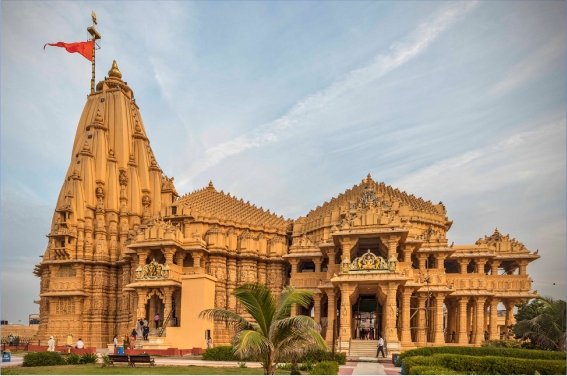Place Name
Shree Dwarkadhish Temple
About
One of ‘The Char Dham’ (four divine abodes), The Dwarkadhish temple, also known as the Jagat Mandir
Where
Dwarka, Gujarat, India
When
21 March 2021

Exploring the Sacred Dwarkadhish Temple: A Divine Abode by the Arabian Sea
In the heart of the holy city of Dwarka, nestled at the western tip of India where the tranquil waters of the River Gomti meet the majestic Arabian Sea, stands the magnificent Dwarkadhish Temple. This sacred site, considered one of ‘The Char Dham’ (four divine abodes), holds a profound significance in Hinduism and is steeped in history, mythology, and architectural grandeur.
Unveiling the Origins
The roots of the Dwarkadhish Temple trace back over 2200 years ago, a time when Lord Krishna’s grandson, Vajranabha, is believed to have erected the original structure. Legend has it that the land for this temple was reclaimed from the sea by Lord Krishna himself, making it a testament to divine intervention and devotion. Over the centuries, the temple faced numerous challenges, enduring the wrath of the sea, and has been reconstructed seven times, with the modern-day structure being the seventh incarnation.
The Architectural Marvel
As described in the Mahabharata, Dwarka is portrayed as a supreme city with opulent architecture, and the Dwarkadhish Temple certainly lives up to this reputation. The temple’s intricate design features a vestibule, sanctum, and a rectangular hall adorned with porches on three sides. Two gateways, Swarga Dwar (Gate to Heaven) on the North and Moksha Dwar (Door to Salvation) on the South, guide visitors on their spiritual journey.
The temple stands tall on 72 monolithic, massive, and exquisitely sculptured pillars, creating a mesmerizing architectural spectacle. The main shrine, a seven-story marvel constructed from soft limestone and granite, serves as the centerpiece. At the highest point, above the sanctum, an awe-inspiring seven-colored silk flag, known as Dhwaja, extends 84 feet into the sky. It is hosted on a pillar that reaches 20 feet in height and spans 52 feet in length. The symbolism of the flag signifies that Lord Krishna’s presence endures until the Sun and Moon cease to exist on Earth.
A Feast for the Senses
Every nook and cranny of the Dwarkadhish Temple is a testament to intricate craftsmanship and devotion. The temple’s walls, pillars, and base are adorned with exquisite carvings featuring depictions of elephants, dancers, heavenly beings, and musicians. This rich detailing creates an immersive and spiritually uplifting experience for visitors.
Janmashtami: A Spectacular Celebration
One of the most special occasions at the Dwarkadhish Temple is the eve of Janmashtami, celebrating the birth of Lord Krishna. On this auspicious day, the temple comes alive with the devotion of thousands of devotees who gather to chant prayers and perform rituals. The air is filled with the melodious sounds of bhajans (devotional songs), and the temple is adorned with vibrant decorations, creating an atmosphere of divine bliss.
A Pilgrimage of Millions
Every year, more than five million people from all corners of the world undertake a pilgrimage to the Dwarkadhish Temple to seek the blessings of Lord Krishna. The temple’s spiritual aura and historical significance make it a must-visit destination for Hindus and tourists alike. It is not just a place of worship but also a site that encapsulates the essence of Hindu spirituality and culture.
Home to the Shankar Acharya Peethas
The Dwarkadhish Temple is not only a place of devotion but also a center of spiritual significance. It is home to one of the four Shankar Acharya Peethas, the Sharda Peetha, further enhancing its importance in the Hindu faith.
Conclusion
The Dwarkadhish Temple, also known as Jagat Temple, Nija Temple, or Trilok Sundar, stands as a testament to the unwavering faith and devotion of countless devotees over millennia. Its captivating architecture, deep-rooted history, and spiritual significance continue to draw pilgrims and travelers, offering a glimpse into the rich tapestry of Indian culture and spirituality.
FAQs:
How old is the Dwarkadhish Temple?
The original temple is believed to have been built over 2200 years ago.
Why is the Dwarkadhish Temple known as 'The Char Dham'?
It is one of the four divine abodes, symbolizing its significance in Hinduism.
What is the significance of the seven-colored silk flag on top of the temple?
The flag signifies that Lord Krishna’s presence endures until the Sun and Moon cease to exist on Earth.
When is the best time to visit the Dwarkadhish Temple?
The eve of Janmashtami, celebrating Lord Krishna’s birth, is a particularly special time to visit.
What is the Sharda Peetha at the Dwarkadhish Temple?
The Sharda Peetha is one of the four Shankar Acharya Peethas, enhancing the temple’s spiritual significance.










